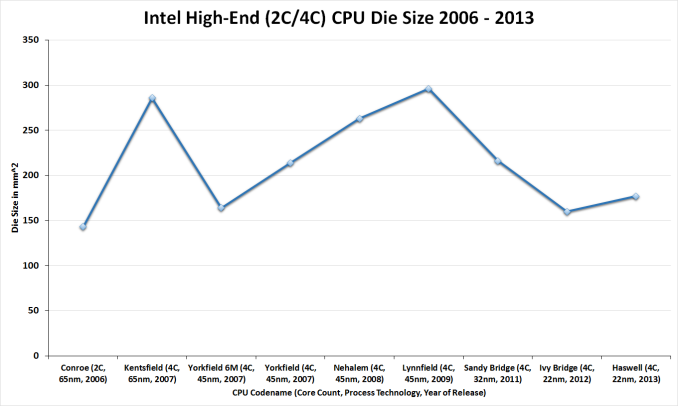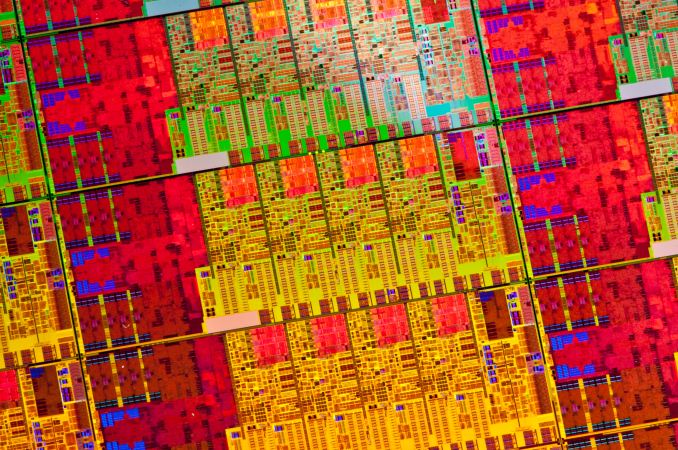The Haswell Review: Intel Core i7-4770K & i5-4670K Tested
by Anand Lal Shimpi on June 1, 2013 10:00 AM ESTDie Size and Transistor Count
Moving on to die sizes and transistor counts, this year Intel is striving to be more straightforward and accurate than was the case with Sandy Bridge and Ivy Bridge. With the Bridge generation we didn’t initially get comparable numbers, only for the correction to throw in additional confusion. For Haswell Intel is laying things out from the start, listing both possible numbers so that either can be compared.
| CPU Specification Comparison | |||||||||
| CPU | Manufacturing Process | Cores | GPU | Transistor Count (Schematic) | Die Size | ||||
| Haswell GT3 4C | 22nm | 4 | GT3 | ? | 264mm2 (est) | ||||
| Haswell GT2 4C | 22nm | 4 | GT2 | 1.4B | 177mm2 | ||||
| Haswell ULT GT3 2C | 22nm | 2 | GT3 | 1.3B | 181mm2 | ||||
| Intel Ivy Bridge 4C | 22nm | 4 | GT2 | 1.2B | 160mm2 | ||||
| Intel Sandy Bridge E 6C | 32nm | 6 | N/A | 2.27B | 435mm2 | ||||
| Intel Sandy Bridge 4C | 32nm | 4 | GT2 | 995M | 216mm2 | ||||
| Intel Lynnfield 4C | 45nm | 4 | N/A | 774M | 296mm2 | ||||
| AMD Trinity 4C | 32nm | 4 | 7660D | 1.303B | 246mm2 | ||||
| AMD Vishera 8C | 32nm | 8 | N/A | 1.2B | 315mm2 | ||||
The two numbers for the most common Haswell configuration, Haswell GT2 4C, are 1.4 billion schematic transistors and 1.6 billion layout transistors. Why and what is the difference? The former count is the number of transistors in the schematic (hence the name), and is generally the number we go by when quoting transistor counts. Meanwhile the second number, the layout number, is the number of transistors used in the fabrication process itself. The difference comes from the fact that while the schematic will use one large transistor – being a logical diagram – production will actually use multiple transistors laid out in parallel for layout and process reasons. So how many transistors does Haswell have? It has both 1.4B and 1.6B, depending on which number we’re after, with 1.4B being the number Intel is passing around.
In any case, even among quad cores Haswell is going to come in a couple of different sizes. Along with the 1.4B transistor, 177mm2 4C/GT2 version of Haswell, there is the 4C/GT3 version of Haswell, which Intel doesn’t list the die size or transistor count for. Based on our rough measurements of the physical die we’re at 264mm2, which including the epoxy covering the die will run a bit large.
Breaking things down to the GPU portion of Haswell, based in turn on these measurements I came up with an 87mm^2 adder for the extra hardware in Haswell GT3 vs. GT2. Doubling that 87mm^2 we get a rough idea of how big the full 40 EU Haswell GPU might be: 174mm^2. If my math is right, this means that in a quad-core Haswell GT3 die, around 65% of the die area is GPU. This is contrary to the ~33% in a quad-core Haswell GT2. I suspect a dual-core + GT3 design is at least half GPU. Meanwhile Crystalwell, the 128MB eDRAM, adds another 84mm2 die (by our measurements) to the entire package.
On a comparative basis, the 4C/GT2 version of Haswell is roughly 200M transistors and 17mm2 bigger than the comparable 4C/GT2 version of Ivy Bridge. The transistor count increase is roughly what we’d expect, with most of those transistors going to Haswell itself while the GPU remains relatively unchanged. Though it’s interesting to note that while this marks a 17% increase in transistors, it’s only an 11% increase in die size. Ivy Bridge was a small die for an Intel, and while Haswell grows larger in exchange for the additional functionality the new architecture provides, it’s still a fairly small GPU and reaches a density greater than Ivy Bridge itself. Or to put this another way, Intel’s last tock CPU, Sandy Bridge, was larger still by almost 40mm2. It’s only once we start adding the relatively big GT3 GPU, and not the CPU, that we see Intel go well above 200mm2.












210 Comments
View All Comments
random2 - Monday, June 3, 2013 - link
Other reviewers are getting the more standard 10-15% difference on average across the board typically seen with Intel and a new gen. introduction over their previous gen. If it's not being seen here, maybe there are benches not included that should be.Achaios - Tuesday, June 4, 2013 - link
1.72 FPS difference between an i7-2600k and an i7-4770k. This is so hopelessly pathetic.My QX9650 and my Asus P5Q Deluxe just got a 2 year life extension. I wonder when it's going to be worth it to finally ditch my 2008 system!!!
Arbie - Wednesday, June 12, 2013 - link
The CPU does not control the FPS you're talking about. Beyond a certain point of CPU power (long ago passed) FPS depends on the external graphics card. A Haswell i7-4770K CPU will, according to the Anandtech benchmarks, be about twice as powerful as your QX9650. At 1/3 the cost, and far less idle power. That's not "pathetic".You may very well not want to upgrade, because you won't see a difference in your games - but that isn't Intel's fault. In fact it's a problem for them and the desktop market in general. Gains in CPU power are becoming irrelevant. As are PC games, BTW, which is why graphics cards are improving so slowly now. In two more years... it will be the same story, except more so.
monohouse - Sunday, June 23, 2013 - link
+1, I upgraded my system:from a E6750 (3800 Mhz, 4MB) to E8400 (4300 Mhz, 6MB)
from GTX 480 (840 Mhz, 1.5 GB) to GTX 580 (930 Mhz, 3 GB)
and got the same FPS in crysis 2 (with MaLDo HD + hi-res textures + DX11)
shows that in some cases, there is no improvement
Gastoncapo - Wednesday, June 5, 2013 - link
honestly, i'm still running my 2500k @5ghz ...i don't see the point in upgrading yet, guess i'll just switch my 580 gtx for a 780 :DNillerboy - Sunday, June 9, 2013 - link
will there be made a review of Intel 4770S?I am considering making a lab with this cpu, and would like to see proformence difference between the Intel 4770 and 4770S.
C433 - Wednesday, June 12, 2013 - link
second this, best would be to also include 4670S and at least one of the T modelsThomasS31 - Monday, June 10, 2013 - link
Anand,What is intels response to the overheating/throttling issues with stock cooler haswell (not OC).
Can you investigate this issue more (as you can as ususal).
Seems there are some manufacturing quality issues with the heat spreader and thermal paste.
Arbie - Wednesday, June 12, 2013 - link
Just some info for others considering a Haswell desktop build.I have just assembled an i5-4670K on an Asus Gryphon Z87 mATX mobo, with 8GB of Corsair Vengenace RAM (1333MHz) and a GTX 650ti graphics board. This is with a 250GB Samsung SSD and a old 500GB mechanical drive. The PSU is a Corsair CX600 80-Plus.
==> At stock clocks, idling on the Windows desktop, this PC pulls only 39W from the wall!
I am amazed. Idle power is important to me since the box is in a poorly-ventilated room. Upping the AC to improve that area would freeze the rest of the house AND cost a bundle. The time periods spent at full load are negligible in comparison. But the performance is there when needed... this CPU is nearly twice as powerful as my Yorkfield build, which idles at 170W, with HD 5770 gfx and an SSD.
So I'm very pleased with Haswell on the desktop. And yes, I could have bought a lower level chip and mobo for this use, saving money and a few more Watts, but I wanted the good stuff and the PC may someday be moved to where an OC would be practical.
emperius - Friday, June 14, 2013 - link
Well I certainly can wait for AMD to truly boost their competition from Sony and Microsoft's budget here. Let's face it, multi-year contract for console apu's should economically boost them massively.